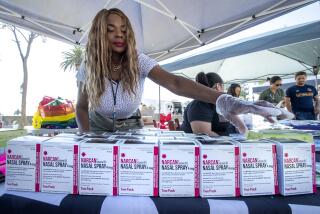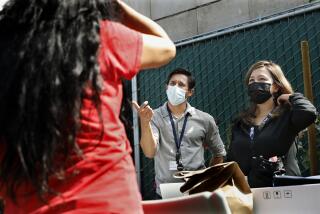Illicit Drug Use by Youths Shows Marked Increase
- Share via
WASHINGTON — Illicit drug use by teen-agers increased significantly between 1992 and 1993, driven by a dramatic rise in the use of marijuana and more use of stimulants, LSD and inhalants, federal officials announced Monday, noting that the trend reverses the downward patterns seen in recent years.
“These findings are more than a warning signal,” Health and Human Services Secretary Donna E. Shalala said at a press conference to announce the results of the annual survey of nearly 50,000 8th-, 10th- and 12th-grade students. “They are an urgent alarm we must heed at once.”
To convey the growing sense of urgency, three Cabinet officers--Shalala, Education Secretary Richard W. Riley and White House Office of Drug Control Policy Director Lee P. Brown--announced the results of the annual survey together, pledging to step up efforts to alter the trend.
While similar studies for Orange County teen-agers are not complete, officials on Monday said that local drug use appears to be stabilizing, with no significant trend shifts in the recent past.
Sandra Fair, a manager with the Orange County Health Care Agency, said that among those teens seeking treatment, the drug used most often is marijuana.
Reflecting a trend in the general population, youths in treatment have shown increased use of LSD, according to Fair. But counselors also have noticed a drop in the use of cocaine and of several drugs at one time.
In Washington, Shalala said she plans to contact the presidents of broadcast networks, film studios, record companies and professional sports leagues to urge them “to rededicate themselves to getting the message out about prevention.” Brown said he will convene a national meeting of experts in prevention and drug education to confront the problem of drug abuse.
“Drug use among American young people has been making a clear comeback in the past two years,” said Lloyd Johnston, the University of Michigan research scientist who conducted the survey, adding that the nation had “been lulled into a false sense of security” by declining numbers in previous years.
William J. Bennett, who first headed the drug policy office during the George Bush Administration, immediately blamed the Clinton Administration for the increases. “Although we still have a serious drug problem in America, the Clinton Administration has been nearly invisible on the drug issue,” he said.
“The Administration’s most prominent voice on drugs,” Bennett said, “has been Surgeon General Joycelyn Elders and her favorable words about drug legalization.” He was referring to Elders’ suggestion that the issue of drug legalization should be studied.
Sen. Joseph R. Biden Jr. (D-Del.), chairman of the Senate Judiciary Committee, said the new pattern “emphasizes the need for immediate action in fighting both drugs and crime.”
The increases “are in part the result of an erosion of anti-drug attitudes by youth,” said Richard A. Millstein, acting director of the National Institute on Drug Abuse. “Now more than ever, we need to counter erroneous messages that glamorize the use of illicit drugs, alcohol and cigarettes.”
The findings cut across all socioeconomic levels and showed that “contrary to conventional wisdom,” black students reported the lowest rates of use for virtually all drugs, Johnston said.
According to the survey, which has been sponsored annually since 1975 by the National Institute on Drug Abuse, the percentage of high school seniors who reported using an illicit drug at least once in their lives increased from 40.7% in 1992 to 42.9% in 1993 but still remained well below the peak level of 65.6% recorded in 1981, the report said. Nevertheless, the 1993 increase reverses a downward trend of use by 12th-graders that began in 1981.
Use of any illicit drug in the past year by high school seniors increased from 27.1% in 1992 to 31% in 1993 after steadily declining from a peak of 54.2% in 1979. Those seniors who said they had used an illicit drug within the last month increased from 14.4% in 1992 to 18.3% in 1993.
The use of marijuana increased by three or four percentage points during the last two years among 8th-, 10th- and 12th-graders, according to Johnston. In 1993, the proportion of students reporting marijuana use in the previous year was 9% for 8th-graders, 19% for 10th-graders and 26% for seniors.
“Put another way, the proportion of 8th-graders using marijuana has increased by half in the last two years, while the proportion of 10th-grade users increased by about a quarter and the proportion of 12th-grade users by about a fifth,” Johnston said. Although the rates are well below the peak levels reached in the late 1970s, “they clearly represent a reversal of the declines we recorded for more than a decade,” he said.
The survey also showed that legal drugs--alcohol and cigarettes--still are the most widely used among the nation’s youth at all grade levels. Two-thirds of eighth-graders and nearly nine-tenths of seniors have tried alcohol, the report said.
Times staff writer Elaine Tassy contributed to this report.
More to Read
Sign up for Essential California
The most important California stories and recommendations in your inbox every morning.
You may occasionally receive promotional content from the Los Angeles Times.









